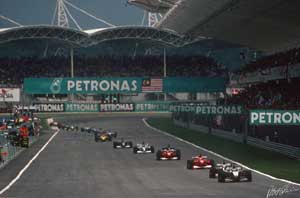Features - Technical
OCTOBER 30, 2000
Blowing in the Wind - CFD v Wind Tunnels
BY DAVID TREMAYNE

Everyone agrees that aerodynamics is the most important part of the F1 design package. But which research route will ultimately be the most effective, the tried and tested wind tunnel, or the increasingly popular mathematical modeling process, Computational Fluid Dynamics?
The Eighties and, particularly, the late Nineties, saw a boom in the development of aerodynamics. At present the focus is on creating the most accurate wind tunnels, and teams such as Benetton actually have a fullsize facility. At present this cannot actually be used in fullscale because of
blockage problems associated with airflow round the sides of the car in the tunnel, but the trend will continue.
Ferrari has brought its fifty percent tunnel on stream in 2000, with obvious effect, and Jordan is actively considering building an all-new facility even though it owns one already in Brackley. "You have to keep developing to keep moving forward," Eddie Jordan says. "One of the things about working with Honda from 2001 is that the kind of stability that confers allows you to undertake such long-term projects."
But really Jordan is talking short-term, if you look ahead over the next century. Wind tunnels will certainly continue to play crucial roles for many years to come, but the really long-term bet may be Computational Fluid Dynamics, of cfd. By developing the right mathematical model, designers and aerodynamicists can predict with tremendous accuracy what a fullscale model is likely to do at any given speed.
Cfd has been around for many years in the aerospace industry, and for some time in F1, but compared to wind tunnels it is still in its infancy.
When Ron Ayers was tasked with developing the supersonic ThrustSSC car, which went on to break the sound barrier on land in 1997 at 763.035 mph, he used cfd in his research. But he also used empirical testing of a scale model fired at 850 mph on a rocket railway, and then compared the two sets of data before drawing the conclusion that the project could be undertaken with a sufficient margin of safety.
In F1, cfd is still used in conjunction with wind tunnels, but that will change. "It's certainly coming on stream now," says Benetton's Pat Symonds. "Most teams have been playing with it for a while and most have been getting some reasonable results from it. It's a long way from being a replacement for a wind tunnel, but it can certainly accelerate development."
"We are building up our cfd at the minute with the help of Ford and it's basically down to how much computing power you've got," Jaguar's Gary Anderson says. "They've got facilities there to make models and run them. Cfd is a good direction finder, it gives you a little bit more understanding of things."
"I think the main thing is that it is not a question of cost but a question of time," Symonds continues. "To do a cfd model of a complete car is a hell of a task. But if you take something simple like a rear wing, for example, with cfd you can probably do 50 rear wings in the time it would take you to do a couple in the wind tunnel. That's where the real benefit comes from."
One of the most significant changes we can expect as the century evolves is the development of cfd, perhaps even to the point where wind tunnels become redundant. But it won't be happening for a while yet.